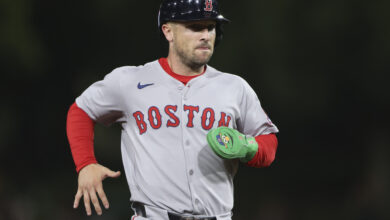
Time to Get PADE: Despite Errors, Cubs Still Have Excellent Defense
We can all agree that errors suck, so I’m not trying to dissuade you from that opinion. There’s nothing worse than seeing Willson Contreras airmail what should be an easy throw or Jason Heyward completely biff a routine (for him) play on a low liner. Then you’ve got the times when El Mago closes his glove early and reveals that he’s not always magic.
But despite their woeful 29 total errors and .980 fielding percentage (both fourth-worst in MLB), the Cubs are actually playing really good defense. Like, solid, elite-level D.
Whoa, buddy, back the truck up. I’ve been watching the Cubs and their defense looks like so much horse crap left behind on Clark street from the mounted police directing traffic after games.
No, hey, I get it. Their errors have been disgustingly glaring and all too frequent, but that doesn’t mean the Cubs aren’t playing good defense otherwise. Some of the errors are mental mistakes, those are going to happen. Others come from trying to do too much or because they’re actually to getting balls that lesser defenders might not even have a play on.
So when we take into account the number of balls in play that the Cubs actually turn into outs, rather than just focusing on the shiny object of errors, the bigger picture comes into focus. That’s where park-adjusted defensive efficiency (PADE) offers an alternative to more traditional measures. It quantifies the percentage of balls in play a team converts to outs and even adjusts for the reality that each ballpark plays differently.
To offer a little context, here are the baselines Baseball Prospectus uses (from 2011 season):
Excellent – Tampa Bay 4.30
Great – Los Angeles of Anaheim 1.47
Average – Atlanta -0.02
Poor – Chicago (A) -1.41
Horrendous – Minnesota -2.41
When the Cubs won the World Series — this was back in 2016, in case you’d forgotten — they were buoyed by a defense that posted an all-time best 6.38 PADE, nearly four times greater than the next-closest team that season (Washington – 1.70). The 2001 Mariners are second in history with a 5.54 and this year’s Astros currently sit third on the list at 5.44. The 2018 Cubs, on the other hand are 28th.
And I don’t mean 28th in MLB this season, but 28th [dramatic pause] of all time. As in, forever and ever. Can I get an amen? Thank you, back in the back, glad to see you’re still awake.
The Cubs’ 3.38 PADE ranks second to the ‘Stros in the current season and is right up there among the best anyone has ever seen. I know that’s hard to believe, but you have to go back to what I mentioned earlier about getting to balls other players simply can’t. More balls, better D.
While the Cubs have missed ample opportunities to make routine plays — and those have cost them more than once — they’re also able to convert batted balls to outs wither greater frequency than almost any other team in the game. So what does this mean for the remainder of the season?
Well, maybe nothing. Or maybe water will find its level and some of those silly mistakes will fall by the wayside as the Cubs’ stellar defense shows out. Not that they’ll stop making errors altogether, that’s just impossible. What we should see, though, is that overall elite talent will eventually overshadow the miscues that seem to be big right now.
You know what will help with that? Scoring more runs and walking fewer batters, which should in turn lead to fewer plays where defenders are trying to record four outs at once.

